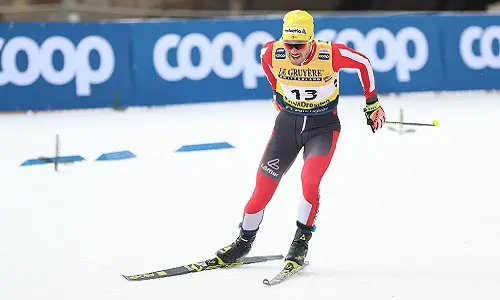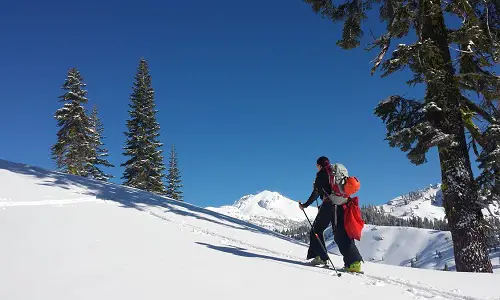Table of Contents
So you have prepared for a great cross country or backcountry ski adventure, you take a glace out your curtains and feel your day is ruined due to bad visibility. What many skiers normally do is to stay indoors and wait for the weather to clear up, despite that this may mean more fun stuff for skiers. What you should be doing is to take advantage of this bad visibility, not ruin your day, and head out to enjoy what you love doing the most, that is, skiing!
In fact, bad visibility can come in as an advantage for you as a lot of skiers decide to remain indoors when there is a white-out or flat light. This means less skiing crowd and you get the mountain to yourself – kind of greedy but all is fair in love, war, and cross country skiing!
Bad Visibility Conditions
Every skier wishes for the perfect weather but bad visibility is part of the snowy winters that we love. So, what exactly are white-out and flat light conditions, and what should we do when we are left with these situations? For this, we need to know what white-out and flat light are so that we know what we are fighting against on the slopes.

What is a White-Out?
When the visibility on the mountains is reduced due to fog, snow, clouds, and wind, it is known as a whiteout. In the case of a whiteout, there is no contrast between the white snow, clouds, and fog and you often face heavy blizzard conditions due to which you can only see a few meters’ distances.
A whiteout can be a strange feeling to go through as our brain feels stranded and isolated, and your nerves can kick in. What you need to know is how to deal with the white out condition so you can enjoy safe skiing when the visibility is not as ideal as you want it to be.
What is Flat Light?
You experience flat light when you are skiing in the clouds, it is snowing or you are under a thick overcast and the sun rays fail to reach the trail on which you are skiing. In such conditions, you cannot differentiate between the texture of the snowy terrain and you find no or little contrast around you that could help you ski with a proper sense of direction.
Flat light is more like an optical illusion. It may not be as severe as a white out, but it is still termed as partial white out as you do not have any visual references.
Most of the ski goggles have two options for their lenses – one for the ideal sunny days and one when you have flat light. When you experience a white out day, make sure to have the right flat light lenses so your goggles can let in more light. As compared to the sunny lenses, these flat light lenses will help in defining and contrasting your surroundings.
Tips for Cross-Country Skiing in Low Visibility
As they say, every cloud has a silver lining, and in the case of cross country and backcountry skiing in low visibility amidst clouds, you need to focus even more on that silver lining. So, are there really any advantages of skiing in low visibility? We have heard and read so much about the negatives of bad visibility that we often tend to ignore the half full portion of the glass.
You get the following advantages when you decide to ski in bad visibility:
- You get the mountain to yourself. This means less crowd and more peaceful days skiing when you can feel your soul connect with the enchanting atmosphere around you.
- While on the slopes, you have to work harder to slide as well as you normally do in good visibility. This polishes your performance so when the sun is out, you can show off your new skill that you learned when the visibility was poor.
For cross country skiing in flat light or white out situations, you need to keep in mind the following tips to be safe in the mountains and still enjoy skiing.

1. Slow Down!
This is probably a good time to focus more on your skills than the pace. When the weather is foggy, it is common sense to drive at a slow speed, and skiing is no exception. Since you are unable to see things after a certain distance, regulate your speed and make sure you do not crash on someone or bump into something. You need to make sure that your speed keeps you as well as people around you safe.
This is also a good time to ski in groups. If you are already skiing with a group of skiers, manage your speed according to theirs or agree upon a steady pace so you do not drift apart. Partnering up is also a good idea even if you are in groups – keep your pace in line with your partner’s and keep an eye on him/ her, and ask him/ her to do the same so that no one gets lost.
Slowing down also means that you take frequent breaks and agree upon the route you are taking. Pre-plan meeting points so that in case any skier or skiers lag behind, they can catch up. In case you are skiing with your family that includes children, it is crucial for you to focus on your speed, and take breaks after short intervals. For your child, your slower pace could be his/ her fastest so keep those tiny feet and small skis in mind when deciding your pace.
2. How to Focus
When the going gets tough, the tough get going. Your eyes and mind need to be more alert and should focus on the surroundings. When the visibility is bad and the weather is not ideal one, you must scan your surroundings from time to time as much as you can. If you find any potential hazard or are not too comfortable to ski further, inform your other group members or your partner to assess the situation.
Look out for piste markers and keep in mind the area you are skiing on. It is important for you to view the piste marker and the map, follow a ski instructor, or talk to your group about navigating on the mountain. Staying informed can help you maintain your focus as you would know what kind of terrain you are approaching and where exactly you are.
The question, how much can you actually see when you focus? You will be amazed at how well you can spot things in poor visibility when you convince your mind to do it and then concentrate. Skiers often give up too quickly and head back. What they fail to do is to look at the right spot to focus at. Let us face it – if you stare at a white cloud, that is all you are going to see – nothingness! But even in the poorest of weather, it is rare to see nothing – find a spot to figure out the rest of the scenery around you. Have you noticed how much you can see in the middle of the night when only a tiny blob of the moon is out? Do that with the white out or the flat light situation, and you will be surprised how you can see and spot things that you were not able to.
Focusing also involves using your sixth sense at times when other senses have given up working or are clueless due to the white-out. Skiing in bad visibility is not the time to take risks so go with your guts. If you feel it is harder for you to proceed in the weather, you have to return back to your resort or hut. But that does not mean you have to be scared about the weather, you only have to be sensible about it and how you use different senses to keep your focus on the land under your feet and around you.
A good way to focus is to look for pockets of better visibility and terrain. You can try skiing in different areas of the mountain to check which one has got better visibility and then focus on that area. If you find trees around your ski resort, you can get pockets of nice visibility and snow.
3. Find Trails Through The Woods
When the visibility is poor, it is a good idea to ski in areas that have trees or are around buildings so you can get some contrast to help you understand the distance or depth in the white out or flat light. Finding trails through the woods is also a great idea as woods have small pockets of visibility and it is better to ski on a trail through such trees.
With the trees causing a contrast to the white surroundings, you can see what lies ahead and can figure out the area you are skiing on. If you know about a certain trail amidst the trees or your ski resort has a trail or two through the woods, it is a good idea to enjoy skiing on those trails to get the best of flat light.
4. Beware of Tree Wells!
When you are skiing around trees, they may provide you with better visibility and contrast to give you a better sense of direction or of what lies ahead, but what about the tree wells? A tree well is created when the branches of a tree stop snow to accumulate around its roots by taking all the snowflakes. You may not see a tree well from a distance when you are skiing because the soft fresh snow covers the well or the hole underneath. But in case you bump into that tree or go near it, gravity and your bodyweight force you down the well (another reason why it is important for you to ski in pairs or groups).
To avoid tree wells, ski without getting too close to the trees. While a tree well can be hard to spot when you are speeding down at a high pace in good visibility, it is even harder to see in bad visibility. For this reason, when skiing in poor visibility, keep trees as a mark to show you the trail or remind you of the mountain you are skiing on, but don’t get too close to them. It is important for you to beware of tree wells and also to keep an eye on your partner in case he/ she falls in one.
In case you fall down a tree well, it is important for you to stay still and grab a branch for support. Shout out to your fellow skiers but hold still. The more you panic and move your arms and legs to climb up the soft snow, the deeper you are going to get stuck. Again, when skiing in poor visibility, stay away from tree wells and keep your eyes on your children or your skiing partner.
5. Goggles with Photochromatic Lenses
A great way to ski in bad visibility is to use the right kind of goggle lenses for the weather. Unlike the dark lenses of your ski goggles that are meant to keep the scorching sun rays away from your eyes (just like your sunglasses or shades), the low light lenses of your goggles are ideal for white out or flat light conditions. While purchasing your ski goggles, you can find the specifications about the lens type (dark or low light) on the pack. What is even a better and a more convenient option is to go for ski goggles with photochromatic lenses.
Using the right lenses could be the difference between an enjoyable skiing experience and a life-threatening and frustrating one. Invest in goggles with photochromatic lenses that automatically adjust to the surrounding light providing you with the best possible visibility.
In snowy conditions, however, make sure the moisture does not go inside these photochromatic lenses and if does, go for a backup goggle instead of using your fingers to wipe off the snow as it could damage the lens. Moisture inside these goggles will also result in your goggles getting fogged up – and that’s the last thing you want when you plan to enjoy hours of cross country skiing.
Conclusion
As a cross country or a backcountry skier, nothing would be more ideal than to go on a skiing trip where there is snow falling all night and the sun shines bright in the morning giving you the perfect visibility and the snowy terrain to glide on. But like every sport, there are good days and bad days. If you know how to use these precious few days and make good days out of them, then there is nothing like it.
Bad visibility is something you cannot do anything about – but we are talking about the weather only. What you can do is follow the above-mentioned tips and instead of curling down with a hot cup of coffee on the sofa, head out and enjoy what nature has to offer. You will not only find more skiing space to yourself when the visibility is poor and other skiers give it a pass, but skiing in such weather will polish your skills – something you can flaunt when the sun comes out shining bright.
Also, take it slow. Nobody will judge you if you do not conquer a certain mountain or stay for as many hours as you normally do on the slopes. It is a good idea to stay away from red and black pistes and go for the easy blue ones instead. Don’t forget to get hold of your piste map. It is better to go for trails that do not split off in multiple directions.
Practice your skills so when the visibility gets better, you can enjoy more skiing without missing out on anything due to bad visibility. Don’t let the visibility stop what you love to do!


